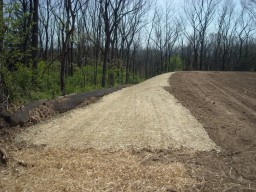Erosion and Sedimentation Pollution Control Program
The statewide goal of this program is to minimize accelerated erosion and sediment pollution that may result from earthmoving activities. Erosion and Sediment Best Management Practices (BMPs) are to be utilized on all earth disturbances.
A written E&S plan shall be prepared and submitted to the Conservation District for review whenever a project involves earth disturbance greater than or equal to 5,000 square feet.
This approved plan must be on-site during the construction activity.

E&S Plan Requirements
The Erosion and Sediment Control Plan should include all of the following items:
- The existing topographic features of the project area and surrounding area. e.g.: roads, streams, woodlands, agricultural fields, wetlands, steep slopes
- The types, depths, slope, locations, and limitations of the soils. See link to NRCS Web Soil Survey below
- The characteristics of the earth disturbance activity, including the past, present, and proposed land uses, and the proposed alteration to the project site.
- The amount of runoff from the project area and its upstream watershed area.
- The location of Waters of The Commonwealth, which may receive runoff within or from the project site and their classification pursuant to Chapter 93. (Existing/Designated use classifications are also visualized on eMapPA.)
- A written depiction of the location and type of perimeter and on site Best Management Practices (BMPs) used before, during, and after the earth disturbance activity.
- A sequence of BMP installation and removal in relation to the scheduling of earth disturbance activities, prior to, during, and after earth disturbance activities.
- Supporting Calculations: e.g. - standard worksheets from E&S Manual
- Plan drawings.
- A maintenance program, which provides for inspection of BMPs on a weekly basis and after each measurable precipitation event, including the repair of the BMPs to ensure effective and efficient operation.
- Procedures which ensure that the proper measures for recycling or disposal of materials associated with or from the project site will be undertaken in accordance with this title.
- Identification of any naturally occurring geological formations or soil conditions with a potential to cause pollution and associated resolutions.
- Identification of potential thermal impacts to surface waters, and any measures taken to avoid/minimize/mitigate these potential impacts.
Small Projects: Half-acre or less
Small Projects disturbing more than 5,000 sf and less than 0.50 acre (21,780 sf) for accessory residential uses (pools, patios, sheds, pole barns, etc.) and with less than 2,000 sf of impervious area, could apply. Additional, restrictions include no steep slopes in excess of 15% and no disturbance of surface waters.
Applications shall be reviewed and approved within 10 business days, if the application is complete and correct. If the District does not respond within 10 business days form the date the application was submitted (applications submitted after noon are considered submitted the following business day), the project will be considered approved, with no further action by the District.
Documents & Forms
All applications for Erosion and Sediment Control Plans submitted to the BCCD must contain these items: A completed Project Application Form, a check for the review fee, and an E&S plan with supporting documents. Please submit two copies of the E&S plan and supporting documents. *All submitted plans need to be folded, rolled plans will not be accepted.
PDF | Word– Non NPDES Project Guidelines
PDF | Word Small Non-NPDES Project Guidelines
PDF – BCCD Standard E&S Notes
PDF – Common Standard Construction Details
LINK - NRCS Web Soil Survey
Word – Single-Lot Post Construction BMP Guidelines for Homeowners
PDF - Standards for Maps and Drawings
PDF - Guidelines for Special Protection Watersheds
PDF - Homeowners Guide to Stormwater BMP Maintenance
PDF – Erosion and Sediment Pollution Control Program Manual
